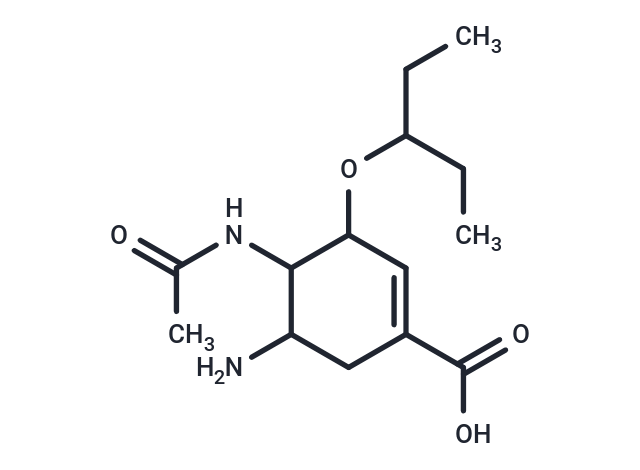Shopping Cart
- Remove All
 Your shopping cart is currently empty
Your shopping cart is currently empty

Oseltamivir acid (GS4071) is a potent influenza virus neuraminidase inhibitor and the prodrug of GS4071.

| Pack Size | Price | Availability | Quantity |
|---|---|---|---|
| 1 mg | $30 | In Stock | |
| 5 mg | $67 | In Stock | |
| 10 mg | $110 | In Stock | |
| 25 mg | $212 | In Stock | |
| 50 mg | $383 | In Stock | |
| 100 mg | $497 | In Stock | |
| 500 mg | $1,130 | In Stock | |
| 1 mL x 10 mM (in DMSO) | $73 | In Stock |
| Description | Oseltamivir acid (GS4071) is a potent influenza virus neuraminidase inhibitor and the prodrug of GS4071. |
| Targets&IC50 | Neuraminidase:100 nM. |
| In vitro | Oseltamivir acid, a potent influenza virus neuraminidase inhibitor, was highly inhibitory to influenza A/NWS/33 (H1N1), A/Victoria/3/75 (H3N2), A/Shangdong/09/93 (H3N2) and B/Hong Kong/5/72 viruses in Madin Darby canine kidney (MDCK) cells. The 50% effective concentrations in these experiments ranged from 1.8 to 59.5 microM, with no cytotoxicity evident at 1000 microM [1]. Influenza B and A/H1N1 viruses were sensitive to oseltamivir (mean B IC50 value: 13 nM; mean H1N1 IC50 value: 1.34 nM). A/H1N2 and A/H3N2 viruses were more sensitive to oseltamivir (mean H3N2 IC50 value: 0.67 nM; mean H1N2 IC50 value: 0.9 nM) [2]. |
| In vivo | The ethyl ester prodrug of Oseltamivir acid, GS4104, administered by oral gavage (p.o.), had significant inhibitory effects on infections in mice induced by these viruses. No toxicity was seen in dosages up to 100 mg/kg/day. The minimum effective dosage for GS4104 was 0.1 mg/kg/day, with the compound administered twice daily for 5 days beginning 4 h pre-virus exposure. Oral therapy with GS4104 could be delayed from 48 to at least 60 h after exposure of mice to influenza A (H1N1) virus and still render a significant antiviral effect, the time of delay being dependent on the viral challenge dose [1]. Oseltamivir produced a dose-dependent antiviral effect against VN1203/04 in vivo. The 5-day regimen at 10 mg/kg/day protected 50% of mice; deaths in this treatment group were delayed and indicated the replication of residual virus after the completion of treatment. Eight-day regimens improved oseltamivir efficacy, and dosages of 1 and 10 mg/kg/day significantly reduced virus titers in organs and provided 60% and 80% survival rates, respectively [3]. |
| Animal Research | Female 6-week-old BALB/c mice were anesthetized with isofluorane and intranasally inoculated with 50 μL of 10-fold serial dilutions of VN1203/04 virus in PBS. The mouse lethal dose (MLD50) was calculated after a 16-day observation period. Oseltamivir was administered by oral gavage twice daily for 5 or 8 days to groups of 10 mice at dosages of 0.1, 1, and 10 mg/kg/day. Control (infected but untreated) mice received sterile PBS on the same schedule. Four hours after the first dose of oseltamivir, the mice were inoculated intranasally with 5 MLD50 of VN1203/04 virus in 50 μL of PBS. Survival and weight change were observed for 24 days. Virus titers in the mouse organs were determined on days 3, 6, and 9 after inoculation. Three mice from each experimental and placebo group were killed, and the lungs and brains were removed. The organs were homogenized and suspended in 1 mL of PBS. The cellular debris was cleared by centrifugation at 2000 g for 5 min. The limit of virus detection was 0.75 log10 EID50. For calculation of the mean, samples with a virus titer <0.75 log10 EID50/mL were assigned a value of 0. Virus titers in each organ were calculated by use of the method of Reed and Muench and are expressed as mean log10 EID50/mL ± SE [3]. |
| Alias | Ro 64-0802, oseltamivir carboxylate, GS 4071 |
| Molecular Weight | 284.35 |
| Formula | C14H24N2O4 |
| Cas No. | 187227-45-8 |
| Smiles | CCC(CC)OC1C=C(CC(N)C1NC(C)=O)C(O)=O |
| Relative Density. | 1.15g/cm3 |
| Storage | Powder: -20°C for 3 years | In solvent: -80°C for 1 year | Shipping with blue ice. | ||||||||||||||||||||||||||||||||||||||||
| Solubility Information | DMSO: 16.67 mg/mL (58.61 mM), Sonication is recommended. H2O: 56 mg/mL (196.94 mM), Sonication is recommended. | ||||||||||||||||||||||||||||||||||||||||
Solution Preparation Table | |||||||||||||||||||||||||||||||||||||||||
DMSO/H2O
H2O
| |||||||||||||||||||||||||||||||||||||||||

Copyright © 2015-2025 TargetMol Chemicals Inc. All Rights Reserved.